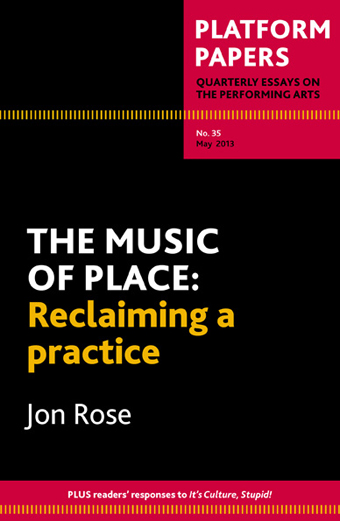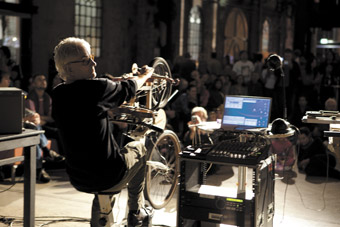Past reclamations, future provocations
Julian Knowles, Jon Rose’s The Music of Place: Reclaiming a Practice
 Opportunities for focused debate on the arts in Australia are somewhat rare. The Currency House Platform Papers series provides an important forum and addresses a range of issues around the changes or decline (whichever way you see it) in Australian arts practices and major performing arts institutions. A glance through the catalogue suggests a reasonable commitment to music from a range of voices, albeit one primarily focused on contemporary classical music and jazz.
Opportunities for focused debate on the arts in Australia are somewhat rare. The Currency House Platform Papers series provides an important forum and addresses a range of issues around the changes or decline (whichever way you see it) in Australian arts practices and major performing arts institutions. A glance through the catalogue suggests a reasonable commitment to music from a range of voices, albeit one primarily focused on contemporary classical music and jazz.
Perhaps reflecting a desire by the editors to expand the frame for Australian music, the series recently departed from more mainstream voices to include a paper on live music from popular music writer Clinton Walker, History is Made at Night. Such diversification has been bolstered by the latest paper, The Music of Place: Reclaiming a Practice, by musician Jon Rose, perhaps Australia’s best known and most senior improvising musician, whose early career grew out of the Australian and European free improvisation scenes in the 1970s and 80s. Rose operated for many years in artist-led underground scenes and came to prominence via his prolific output and collaborations with key international players in improvised music and ‘progressive’ new music.
Rose’s offering is a bold manifesto for arresting the decline in the value of music in Australian society, underpinned by a sense of cultural amnesia around the complex interwoven musical histories across Indigenous and non-indigenous cultures. The paper is structured on a thematic level around a critique of the dominant understanding of Australian music history; the relationship of music to place, landscape and society; perceptions of the value of music; music in public life; and the condition of music in an increasingly technologised world.
To set the tone for the paper Rose writes, “not so long ago a musicologist at a Sydney University seminar observed, ‘Everybody knows that music in Australia didn’t really get going until the mid-1960s.’” This historical lie becomes a ‘hook’ that provides the paper with a sense of real purpose and throws into stark relief the prevailing myopic academic and institutional view of Australian music that becomes one of Rose’s key targets. It is not so much the injustice arising from a situation where “the loudest lie becomes the truth” (as John Zorn writes in the preface) so much as the way in which this kind of skewed outlook prevents us from understanding the true role (and value) that music has had, currently has and may potentially have within Australian culture.
Rose confronts this somewhat absurd portrayal of Australia as an outpost of Europe in which little of historical value might have occurred and suggests that such readings of Australian music have contributed to its devaluing, not just historically and culturally, but also economically. In response, he sets about the task of constructing an alternative narrative (which he calls “the other Australia”) that connects the history of Indigenous music making with Australia’s colonial history in useful and persuasive ways. Rose sketches the musical interactions between the Indigenous population and ‘whitefellas’ from the early 19th century, the influence of the church missions of Hermannsberg and New Norcia with their curious syncretic musical outcomes, and the idiosyncratic musical scenes that grew out of 19th century Australia. He concludes with an outline of Australia’s rich history of musical instrument design and early experiments in electronic music that challenge the dominant view that electronic music started in the 1950s.
In compiling this alternative narrative, Rose draws heavily on the work of musicologists John Whiteoak and Alison Rabinovici, supplemented by private conversations with a range of practitioners. Rose’s main contribution here is the idea that this false history around Australian music constitutes a major stumbling block for its future—that the fundamental lack of awareness of our own history found among musicians and major institutions presents us with a kind of dead end.

Jon Rose, Pursuit
photo Alex Davies
Jon Rose, Pursuit
Rose proposes, as an alternative, a rethinking of music that grows out of a return to first principles—where music reconnects with concepts of place, landscape, everyday life and the Australian vernacular. Invoking ironic references to European modernism, Rose offers examples of Australian sprechstimme—the race-caller or auctioneer and, with a nod to Olivier Messiaen, suggests that our native bird-song “should be standard knowledge and repertoire.” He further outlines the possibilities for outdoor performances and suggests that Australians’ love of sport could be seen as a fruitful site for musical engagement, citing his own work Perks (1995)—“an interactive badminton game based on the mind and obsessions of Percy Grainger”—and Pursuit (2009) “a bicycle powered orchestra event of hand-made musical instruments.” The thrust of these arguments rests on notions of “embeddedness,” where music is interwoven once again into the fabric of everyday life and connects in authentic ways with our environment and culture.
Rose offers a range of provocations around funding arrangements for major arts institutions and how they may act as barriers to achieving the aim of increasing the value of music and musicians. In a section entitled Resisting the capitalists, Rose cites Australia Council funding distributions where in 2009 “Opera Australia received more funding…than all the applicants for all six of the Australia Council’s major boards combined…That’s one opera company receiving more than seven hundred and eighty one separately funded projects across all those forms.” In the following section, New buildings or new resources?, Rose cites a $1.148 billion spend on major public buildings in the last decade, yet “none of this actually goes to employing musicians to play music…How many open-air concerts of new music could we get for $1.148 billion, hiring ten musicians a concert at $500 each? Some 2,296,000 concerts.” Much of Rose’s argument centres on the idea that we have a system of institutional support that is poorly calibrated towards achieving a vibrant and distinctive future for Australian music. He proposes that we consider what would happen if all this funding were removed and music needed to find a new context that arose out of authentic expression and basic value exchange.
In respect of new technologies Rose takes a fairly dim view of the promise of the internet, arguing that it has provided little concrete assistance to musicians (“the internet is a self-replicating, self-reflective system of almost pure noise”), and further, that the old way of organising tours via letters and telephones was more fruitful and efficient. He concludes his assessment of our digital present and future by re-asserting the value of physical presence and the body as key agents in musical exchange, “music without the agency of the body is music without breath.”
This is an expansive and engaging view of the state of Australian music. Rose’s approach to this Platform Paper closely resembles his prolific and influential musical output. His arguments demonstrate a lateral, creative form of thinking that challenges traditional understandings of history, culture and genre, resulting in a provocative collision of ideas out of which a powerful logic emerges.
Plaftform Papers: Jon Rose, The Music of Place: Reclaiming a Practice, Currency House http://www.currencyhouse.org.au/node/278
See Jon Rose’s response to City of Sydney public conversation on live music 26 June; and a review of Jon Rose’s 60th Anniversary CD box set, Rosin
This article fist appeared as part of RealTime’s online e-dition July 10, 2013
RealTime issue #116 Aug-Sept 2013 pg. 48






